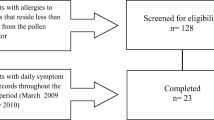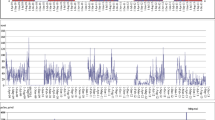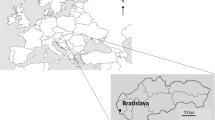Abstract
About 30% of the Hungarian population has some type of allergy, 65% of them have pollen sensitivity, and at least 60% of this pollen sensitivity is caused by ragweed. The short (or common) ragweed (Ambrosia artemisiifolia = Ambrosia elatior) has the most aggressive pollen of all. Clinical investigations prove that its allergenic pollen is the main reason for the most massive, most serious and most long-lasting pollinosis. The air in the Carpathian Basin is the most polluted with ragweed pollen in Europe. The aim of the study is to analyse how ragweed pollen concentration is influenced by meteorological elements in a medium-sized city, Szeged, Southern Hungary. The data basis consists of daily ragweed pollen counts and averages of 11 meteorological parameters for the 5-year daily data set, between 1997 and 2001. The study considers some of the ragweed pollen characteristics for Szeged. Application of the Makra test indicates the same period for the highest pollen concentration as that established by the main pollination period. After performing factor analysis for the daily ragweed pollen counts and the 11 meteorological variables examined, four factors were retained that explain 84.4% of the total variance of the original 12 variables. Assessment of the daily pollen number was performed by multiple regression analysis and results based on deseasonalised and original data were compared.






Similar content being viewed by others
References
Bartzokas A, Metaxas DA (1993) Covariability and climatic changes of the lower troposphere temperatures over the Northern Hemisphere. Nouvo Cimento 16C:359–373
Bartzokas A, Metaxas DA (1995) Factor analysis of some climatological elements in Athens, 1931–1992: covariability and climatic change. Theor Appl Climatol 52:195–205
Comtois P (1998) Ragweed (Ambrosia sp.): the phoenix of allergophytes. In: Spiestsma FT (ed) Satellite Symposium Proceedings: Ragweed in Europe. 6th International Congress on Aerobiology, Perugia, Italy, 31 August – 5 September 1998. Alk-Abello, Horsholm, pp 3–5
Fehér Z, Járai-Komlódi M (1997) An examination of the main characteristics of the pollen seasons in Budapest, Hungary (1991–1996). Grana 36:169–174
Fornaciari M, Bricchi E, Greco F, Fascini D, Giannoni C, Frenguelli G, Romano B (1992) Daily variations of Urticaceae pollen count and influence of meteoclimatic parameters in East Perugia during 1989. Aerobiologia 8:407–413
Galán C, Alcázar P, Cariňanos P, Garcia H, Domínguez-Vilches E (2000) Meteorological factors affecting daily Urticaceae pollen counts in southwest Spain. Int J Biometeorol 43:191–195
Galán C, Cariňanos P, Garcia-Mozo H, Alcázar P, Domínguez-Vilches E (2001) Model for forecasting Olea europaea L. airborne pollen in South-West Andalusia, Spain. Int J Biometeorol 45:59–63
Giner MM, Carrión Garcia JS, Garcia Sellés J (1999) Aerobiology of Artemisia airborne pollen in Murcia (SE Spain) and its relationship with weather variables: annual and intradiurnal variations for three different species. Wind vectors as a tool in determining pollen origin. Int J Biometeorol 43:51–63
Jäger S (1998) Global aspects of ragweed in Europe. In: Spiestsma FT (ed) Satellite Symposium Proceedings: Ragweed in Europe. 6th International Congress on Aerobiology Perugia, Italy, 31 August – 5 September 1998. Alk Abello, Horsholm, pp 6–8
Járai-Komlódi M, Juhász M (1993) Ambrosia elatior (L.) in Hungary (1989–1990). Aerobiologia 9:75–78
Jato MV, Rodríguez FJ, Seijo MC (2000) Pinus pollen in the atmosphere of Vigo and its relationship to meteorological factors. Int J Biometeorol 43:147–153
Jolliffe IT (1990) Principal component analysis: a beginner’s guide I. Introduction and application. Weather 45:375–382
Jolliffe IT (1993) Principal component analysis: a beginner’s guide II. Pitfalls, myths and extensions. Weather 48:246–253
Juhász M (1995) New results of aeropalynological research in Southern Hungary. Publications of the Regional Committee of the Hungarian Academy of Sciences, Szeged 5:17–30
Käpylä M, Penttinen A (1981) An evaluation of the microscopial counting methods of the tape in Hirst-Burkard pollen and spore trap. Grana, 20:131–141
Makra L, Tar K, Horváth Sz (2000) Some statistical characteristics of the wind energy over the Great Hungarian Plain. Ambient Energy 21:85–96
Makra L, Horváth Sz, Pongrácz R, Mika J (2002) Long term climate deviations: an alternative approach and application on the Palmer drought severity index in Hungary. Phys Chem Earth 27:1063–1071
Nilsson S, Persson S (1981) Tree pollen spectra in the Stockholm region (Sweden), 1973–1980. Grana 20: 179–182
Sindosi OA, Katsoulis BD, Bartzokas A (2003) An objective definition of air mass type affecting Athens Greece; the corresponding atmospheric pressure and air pollution levels. Environ Technol 24:947–962
Tar K, Makra L, Horváth Sz, Kircsi A (2001) Temporal change of some statistical characteristics of wind speed over the Great Hungarian Plain. Theor Appl Climatol 69:69–76
Acknowledgements
The authors would like to express their gratitude to Helfried Scheifinger (Zentralanstalt fuer Meteorologie und Geodynamik, Vienna, Austria) for valuable help and advice, and to Szilvia Horváth and (Department of Climatology and Landscape Ecology, University of Szeged, Hungary), Gábor Motika (Environmental Protection Inspectorate of Lower-Tisza Region, Szeged, Hungary) and Predrag Radisic (University of Novi Sad, Laboratory of Palinology and Ecology, Novi Sad, Serbia-Montenegro) for useful hints on the topic. This study was supported by the Hungarian National Foundation for Scientific Research (OTKA no. T 034765).
Author information
Authors and Affiliations
Corresponding author
Rights and permissions
About this article
Cite this article
Makra, L., Juhász, M., Borsos, E. et al. Meteorological variables connected with airborne ragweed pollen in Southern Hungary. Int J Biometeorol 49, 37–47 (2004). https://doi.org/10.1007/s00484-004-0208-4
Received:
Accepted:
Published:
Issue Date:
DOI: https://doi.org/10.1007/s00484-004-0208-4




